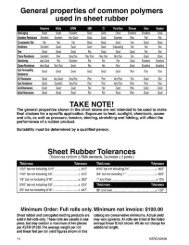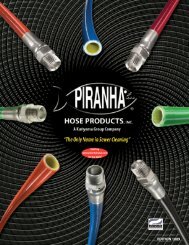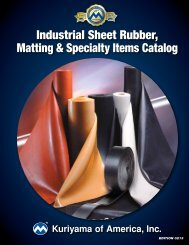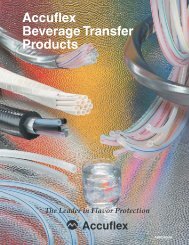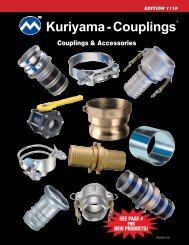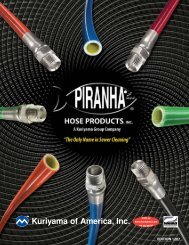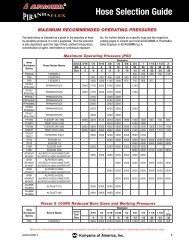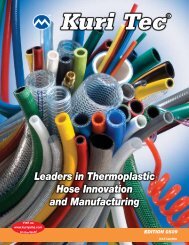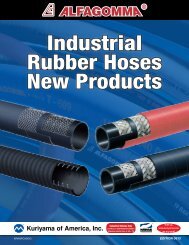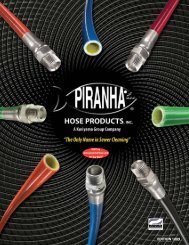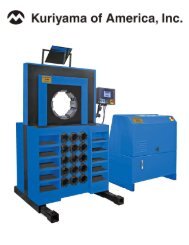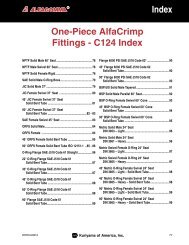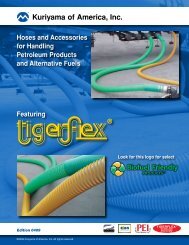Rubber Hoses - Kuriyama of America
Rubber Hoses - Kuriyama of America
Rubber Hoses - Kuriyama of America
You also want an ePaper? Increase the reach of your titles
YUMPU automatically turns print PDFs into web optimized ePapers that Google loves.
Care, Maintenance & Storage<br />
(Reprinted from RMA Hose Handbook 1 P-2 - Fourth Edition)<br />
Hose has a limited life and the user must be alert to signs <strong>of</strong> impending<br />
failure, particularly when the conditions <strong>of</strong> service include high working<br />
pressures and/or the conveyance or containment <strong>of</strong> hazardous materials,<br />
GENERAL CARE<br />
AND MAINTENANCE OF HOSE<br />
Hose should not be subjected to any form <strong>of</strong> abuse in service. It should be<br />
handled with reasonable care. <strong>Hoses</strong> should not be dragged over sharp or<br />
abrasive surfaces unless specifically designed for such service. Care should<br />
be taken to protect hose from severe end loads for which the hose or hose<br />
assembly were not designed. Hose should be used at or below its rated<br />
working pressure; any changes in pressure should be made gradually so as to<br />
not subject the hose to excessive surge pressures. Hose should not be kinked<br />
or be run over by equipment. In handling large size hose, dollies should be<br />
used whenever possible; slings or handling rigs, properly placed, should be<br />
used to support heavy hose used in oil suction and discharge service.<br />
STORAGE<br />
<strong>Rubber</strong> hose products in storage can be affected adversely by temperature,<br />
humidity, ozone, sunlight, oils, solvents, corrosive liquids and fumes, insects,<br />
rodents and radioactive materials.<br />
The appropriate method for storing hose depends to a great extent on its<br />
size (diameter and length), the quantity to be stored, and the way in which it<br />
is packaged. Hose should not be piled or stacked to such an extent that the<br />
weight <strong>of</strong> the stack creates distortions on the lengths stored at the bottom.<br />
Since hose products vary considerably in size, weight, and length, it is not<br />
practical to establish definite recommendations on this point. Hose having a<br />
very light wall will not support as much load as could a hose having a heavier<br />
wall or hose having a wire reinforcement. Hose which is shipped in coils or<br />
bales should be stored so that the coils are in a horizontal plane.<br />
Whenever feasible, rubber hose products should be stored in their original<br />
shipping containers, especially when such containers are wooden crates or<br />
cardboard cartons which provide some protection against the deteriorating<br />
effects <strong>of</strong> oils, solvents, and corrosive liquids; shipping containers also afford<br />
some protection against ozone and sunlight.<br />
Certain rodents and insects will damage rubber hose products, and adequate<br />
protection from them should be provided.<br />
The ideal temperature for the storage <strong>of</strong> rubber products ranges from 50° to<br />
70°F (10-20°C) with a maximum limit <strong>of</strong> 100°F (38°C). If stored below 32°F<br />
(0°C), some rubber products become stiff and would require warming before<br />
being placed in service. <strong>Rubber</strong> products should not be stored near sources<br />
<strong>of</strong> heat, such as radiators, base heaters, etc., nor should they be stored under<br />
conditions <strong>of</strong> high or low humidity.<br />
To avoid the adverse effects <strong>of</strong> high ozone concentration, rubber hose products<br />
should not be stored near electrical equipment that may generate ozone<br />
or be stored for any lengthy period in geographical areas <strong>of</strong> known high ozone<br />
concentration. Exposure to direct or reflected sunlight — even through windows<br />
— should also be avoided. Uncovered hose should not be stored under<br />
fluorescent or mercury lamps which generate light waves harmful to rubber.<br />
Storage areas should be relatively cool and dark, and free <strong>of</strong> dampness and<br />
mildew. Items should be stored on a first-in, first-out basis, since even under<br />
the best conditions, an unusually long shelf life could deteriorate certain<br />
rubber products.<br />
Flexibility & Bend Radius<br />
Flexibility and minimum bend radius are important factors in hose design and<br />
selection if it is known that the hose will be subjected to sharp curvatures in<br />
normal use. When bent at too sharp an angle, hose may kink or flatten in the<br />
cross-section. The reinforcement may also be unduly stressed or distorted<br />
and the hose life thereby shortened.<br />
Adequate flexibility means the hose should be able to conform to the<br />
smallest anticipated bend radius without over stress. The minimum bend<br />
radius is generally specified for each hose in this catalog. This is the radius to<br />
which the hose can be bent in service without damage or appreciably<br />
shortening its life. The radius is measured to the inside <strong>of</strong> the curvature.<br />
Formula to determine minimum hose length given bend radius and<br />
degree <strong>of</strong> bend required:<br />
Technical Data<br />
Thus, the bend must be made over approximately 16 cm <strong>of</strong> hose length. The<br />
bend radius used must be equal to or greater than the rated minimum bend<br />
radius. Bending the hose to a smaller bend radius than minimum may kink the<br />
hose and the result in damage and early failure.<br />
Oil Resistance<br />
The definition <strong>of</strong> Oil Resistance is currently related to Tensile Retention % and<br />
Volume Swell % <strong>of</strong> the tested material after immersion in ASTM No. 3 Oil and<br />
in ASTM Fuel B for 70 hours at 100°C (212°F). The hose industry is currently<br />
classifying the materials as follows:<br />
Where:<br />
L = Minimum length <strong>of</strong> hose to make bend (Bend must be made equally<br />
along this portion <strong>of</strong> hose length).<br />
A = Angle <strong>of</strong> bend<br />
B = Given bend radius <strong>of</strong> hose<br />
= 3.14<br />
Example: To make a 60° bend at the hoses’s rated minimum bend radius <strong>of</strong><br />
15 cm:<br />
Safety Features<br />
Air hose — 4:1 Safety factor. Burst vs Working pressure<br />
Water hose — 3:1 Safety factor. Burst vs Working pressure<br />
Steam hose — 10:1 Safety factor. Burst vs Working pressure<br />
KRHCA0507<br />
KRHCA0109 57



